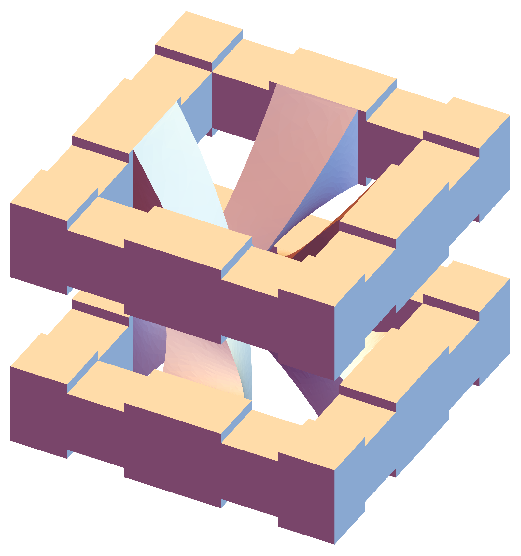How to handle fragile states
A concept known as ‘fragile topology’ has been puzzling physicists ever since it emerged two years ago. Two teams, one led by ETH physicists, have now developed a comprehensive theoretical and experimental framework to pin down the essence of the concept — and establish ways how to potentially harness it in applications.
“Just knowing the correct laws of quantum mechanics does not mean that one understands all the strange phenomena that it allows. What has been learned is that it can do ‘really cool things’ that had never been guessed at before, and might some day actually be practically useful.”
These were the words of Duncan Haldane at the 2016 Nobel Banquet, spoken after just having received that year’s Nobel Prize in Physics, together with his colleagues David Thouless and Michael Kosterlitz. The trio has been honoured for pioneering works in a field that is now known as topological physics. In the few years since that banquet evening, the field has kept expanding at a tremendous pace — throwing up many more ‘strange phenomena’ on the way. The wealth and diversity of the discoveries makes it all the more important to have overarching frameworks that provide a higher-level understanding of these phenomena, and ideally a practical handle on how to control and eventually exploit them in applications. Writing in a pair of papers published today in the journal Science [1,2], two collaborations of researchers from across the world, one led by Dr Sebastian Huber from the Institute for Theoretical Physics at ETH Zurich, present theoretical and experimental work that provides just such a framework for one of the landmark effects of topological physics.
Ever stranger things
One of the ‘really cool things’ that Haldane is likely to have had in mind are materials known as topological insulators. These possess the property that they do not allow electrical charges to flow through their bulk interior — making them insulators — but, perplexingly, on their surface charges can move essentially unimpeded. More recently, it transpired that topological insulators might be far from being ‘exotic’. According to numerical studies, a quarter or so of all non-magnetic materials might belong to that class. What precisely defines this ‘class’ has been repeatedly called into question though. Most dramatically so probably in a body of theoretical works that have emerged since 2018, introducing the concept of ‘fragile topology’. Fragile topological insulators share many commonalties with their ‘stable’ counterparts, but not the tell-tale property of perfect conduction at the surface. Taking on board fragile states, topological insulators might even become the most common form of insulators. With such perspectives on the horizon, making sense of these systems kept quite some physicist awake at night.
A handle on fragile topology
Hence the excitement as Andrei Bernevig and Zhi-Da Song from Princeton University (US) and Luis Elcoro from the University of the Basque Country (Spain) present now, in one of the two Science papers [1], a theoretical framework that provides the tools to understand how the bulk and the surface properties are connected in topological insulators, including those of the fragile sort. Importantly, they lay out ways in which their insight can be used to determine whether or not a given material is a fragile topological insulator.
Performing the sort of transformations that Bernevig and his co-workers prescribe on a crystalline solid would be, however, extremely challenging. An immediate experimental implementation has been possible nonetheless, thanks to Sebastian Huber and his group for Condensed Matter Theory and Metamaterials at ETH Zurich. Huber is a pioneer in taking concepts related to topology in quantum mechanical systems (such as electrons in a crystal) and translating them to classical systems harbouring mechanical or sound waves, which then share the same topological properties — opening the gate to exploring, beyond the realm of quantum physics, phenomena that had never been guessed at before (to lean on Haldane’s words once more).
A classical solution

Together with his PhD student Valerio Peri and further team members, and working with colleagues in Israel, China, and with Bernevig in Princeton, Huber performed experiments with a so-called acoustic metamaterial, as they report in the second Science paper [2]. In this structure, produced by 3D printing, the unit cells are not of atomic but of centimetre dimensions (see the figure). Working with such an intricate macroscopic structure provided the possibility to finely tune the properties of the material, and in particular the ways in which the airwaves can propagate through it.
This exquisite control enabled the team not only to establish unequivocally the presence of fragile topological states in their metamaterial, but also to show for the first time, in any system, a clear experimental signature that is a direct consequence of the abstract concept of fragile topology. And with possible applications to acoustics or photonics — the same concepts hold for light waves — we can look forward to further excitement in the years to come.
References
1. Song Z, Elcoro L, Bernevig BA: Twisted bulk-boundary correspondence of fragile topology. Science 367, 794 (2020). external page DOI:10.1126/science.aaz7650 external page Preprint
2. Peri V, Song ZD, Serra-Garcia M, Engeler P, Queiroz R, Huang X, Deng W, Liu Z, Bernevig BA, Huber SD: Experimental characterization of fragile topology in an acoustic metamaterial. Science 367, 797 (2020). external page DOI: 10.1126/science.aaz7654 external page Preprint
